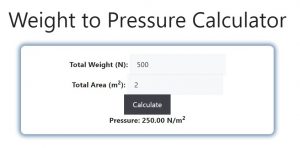About Weight to Pressure Calculator (Formula)
The Weight to Pressure Calculator is a practical tool that allows users to determine the pressure exerted by a weight on a specific surface area. Understanding the relationship between weight and pressure is crucial in various fields, including engineering, physics, and materials science. This calculator can help assess the forces acting on structures, evaluate material properties, and ensure safety in design processes. By providing accurate calculations, it empowers users to make informed decisions based on physical principles.
Formula
The formula to calculate pressure from weight is:
Pressure = Weight / Surface Area
Where:
- Weight is the force exerted by the mass of an object due to gravity, typically measured in newtons (N) or pounds (lbs).
- Surface Area is the area over which the weight is distributed, measured in square meters (m²) or square inches (in²).
How to Use
To use the Weight to Pressure Calculator, follow these simple steps:
- Determine the Weight: Measure or obtain the weight of the object whose pressure you want to calculate. Ensure it is in the correct units (newtons or pounds).
- Measure the Surface Area: Calculate the surface area over which the weight is distributed. This could be the area of a base, a footprint, or any relevant surface.
- Input Values: Enter the weight and surface area into the calculator.
- Calculate Pressure: Click the calculate button to find the pressure exerted by the weight on the specified surface area.
Example
Let’s consider an example to illustrate how to use the Weight to Pressure Calculator:
- Weight: 500 newtons
- Surface Area: 2 square meters
Using the formula:
Pressure = Weight / Surface Area
Pressure = 500 N / 2 m²
Pressure = 250 N/m² (or Pascals)
In this example, the pressure exerted is 250 Pascals, indicating the force per unit area applied by the weight.

FAQs
- What is pressure?
Pressure is defined as the force applied per unit area on a surface. - How is weight measured?
Weight is typically measured in newtons (N) or pounds (lbs) using scales or balances. - What units are used for pressure?
Pressure is measured in Pascals (Pa), atmospheres (atm), or pounds per square inch (psi). - How do I convert weight from pounds to newtons?
To convert pounds to newtons, multiply the weight in pounds by 4.448. - Can I use this calculator for liquids?
Yes, the calculator can be used for both solids and liquids to determine pressure. - What factors affect pressure?
Pressure is influenced by the weight of the object and the surface area over which it is distributed. - Is the Weight to Pressure Calculator accurate?
Yes, the calculator provides accurate results based on the input values. - How can pressure impact material strength?
Excessive pressure can lead to material deformation or failure, highlighting the importance of calculations in design. - What is the difference between pressure and force?
Pressure is the force per unit area, while force is simply the weight or push without consideration of area. - Can I calculate pressure for irregularly shaped objects?
Yes, measure the effective contact area and input it into the calculator for accurate results. - How do I measure surface area for complex shapes?
Break down complex shapes into simpler geometric figures and calculate the total area. - What happens if the surface area is zero?
If the surface area is zero, pressure cannot be calculated, as it would lead to division by zero. - Can this calculator be used in engineering applications?
Absolutely, it is widely used in engineering to assess loads and stresses on materials and structures. - What is a safe pressure limit?
Safe pressure limits vary by material and application; consult engineering guidelines for specific limits. - Is the calculator suitable for pneumatic applications?
Yes, the Weight to Pressure Calculator can also be applied to pneumatic systems where weight and surface area are relevant. - What is gauge pressure?
Gauge pressure measures pressure relative to atmospheric pressure, excluding the weight of the atmosphere. - Can pressure affect fluid behavior?
Yes, pressure changes can impact fluid dynamics, including flow rates and turbulence. - How do temperature and pressure relate?
Temperature changes can affect the density of gases and liquids, influencing pressure readings. - What are some common applications for pressure calculations?
Common applications include building design, automotive engineering, and fluid mechanics. - How often should I recalculate pressure?
Recalculate whenever there are changes in weight, surface area, or environmental conditions affecting pressure.
Conclusion
The Weight to Pressure Calculator is an invaluable tool for anyone needing to understand the dynamics of weight distribution and pressure. By applying the formula and following the simple steps outlined, users can quickly and accurately calculate pressure for various applications. This understanding is crucial in fields ranging from engineering to environmental science, ensuring that designs and structures can withstand applied forces without failure. Regular use of this calculator will enhance your ability to make informed decisions based on fundamental physical principles.